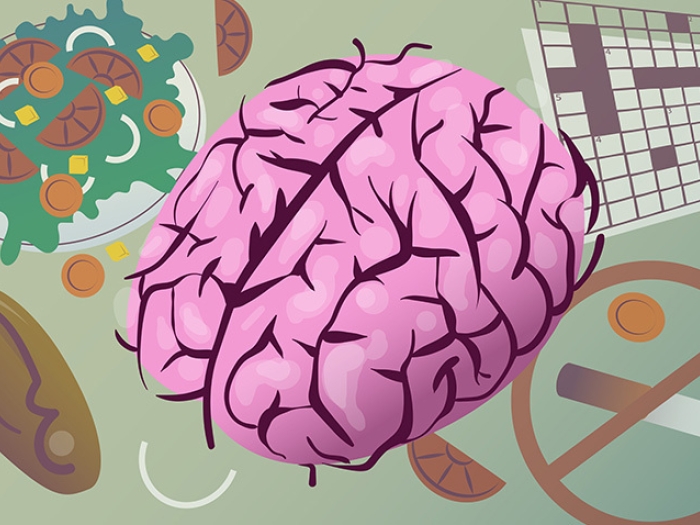Learn the signs, symptoms and more
11:10 AM
Author |

Less than one year after stepping away from acting due to a diagnosis of aphasia, Bruce Willis has been diagnosed with frontotemporal dementia, according to a statement from his family.
“Unfortunately, challenges with communication are just one symptom of the disease Bruce faces,” the statement read in part. “FTD is a cruel disease that many of us have never heard of and can strike anyone.”
Frontotemporal dementia is a progressive and degenerative condition of the brain. It’s called a dementia due to the gradual decline in cognitive function, but it is very different from the more common dementias that one may typically associate with the word, says Sami Barmada, M.D., Ph.D., a neurologist at U-M Health whose research program focuses on FTD and its overlap with amyotrophic lateral sclerosis, or ALS.
Here Barmada answers key questions about FTD.
What are the signs and symptoms of FTD?
Barmada: In FTD, people may lose motivation or interest in their activities, or they start behaving rashly and without restraint. They may say or do things that are very out of character. Partners often say that their significant other no longer cares about them in the same way that they used to. People with FTD may also show a gradual decline in their language — to the point where they are unable to communicate with friends and family. FTD may also affect our ability to move, leading to falls, tremor, the inability to perform complex actions or muscle weakness.
Who gets FTD?
Barmada: FTD tends to appear earlier than other types of dementia, usually before the age of 65. Men are slightly more at risk than women, but there are no other specific risk factors that we know of besides family history. Up to four out of every 10 people with FTD will have a family history suggestive of the condition. This is challenging, however, since FTD may not have been accurately diagnosed in previous generations, masquerading instead as schizophrenia, depression, Alzheimer's disease, Parkinson's disease or other conditions.
What is the key difference between FTD and Alzheimer’s?
Barmada: The single most important difference between FTD and Alzheimer’s is the relative preservation of memory in FTD. People with FTD often have an intact memory for facts and people, which is usually not the case for those with Alzheimer’s disease. Other differences that might suggest FTD include an age of 65 years or younger, behavioral or personality changes and language problems in the absence of frank decline in memory.
Additional, specialized testing may be required to discriminate the conditions — this may involve a neurological examination, brain imaging via MRI or PET scan, testing of the fluid that surrounds the brain and spinal cord for proteins that build up in each condition, genetic testing and/or detailed cognitive testing. Blood tests may soon be available for Alzheimer’s disease, which may help identify FTD by default if the tests are negative.
What, if any, are the treatments for FTD?
Barmada: There are no medications that treat the heart of FTD and can stop the progression of disease. That being said, there are many therapies and approaches that target the varied symptoms associated with FTD. These include medications that are often used to treat depression, anxiety, delusions or tremor.
Just as important is to make sure that people are not taking medications that may exacerbate FTD, and each visit involves a careful review of medications for necessity and potential for harm. Non-pharmacological measures can also be very helpful — these include ensuring adequate and restful sleep, regular physical activity, engaging in activities that challenge the mind, relieving stress when and where possible, and eating a balanced diet that is rich in plant products (less so in meats).
What research is being done on FTD and treatments?
Barmada: There is a lot of active research going on here at Michigan Medicine, and elsewhere around the country and the world. Our laboratory focuses on the origin of FTD — why does this disease occur, what is responsible for the gradual decline in function, and what can we do about it?
Others at Michigan Medicine are testing new and exciting therapies, including Benjamin Hampstead, Ph.D., and Tanav Popli, M.D., who utilize transcranial direct current stimulation to engage and improve function in the language regions of the brain. We are also a site for one of the largest studies of FTD in the world. With this investigation, we will learn how best to recognize FTD, and how to gauge if and how people are responding to treatment.
Outside of U-M, there are several treatments that are under development. These include some in the last stage of testing in people (Phase 3 trials), some in the intermediate stages (Phase 2 trials) and more in the earliest stages.
Right now, most of these treatments are limited to individuals with a familial form of FTD and a known mutation. However, many of the same treatments may transition to all people with FTD if they show promise in these early studies.

Explore a variety of health care news & stories by visiting the Health Lab home page for more articles.

Department of Communication at Michigan Medicine

Want top health & research news weekly? Sign up for Health Lab’s newsletters today!





